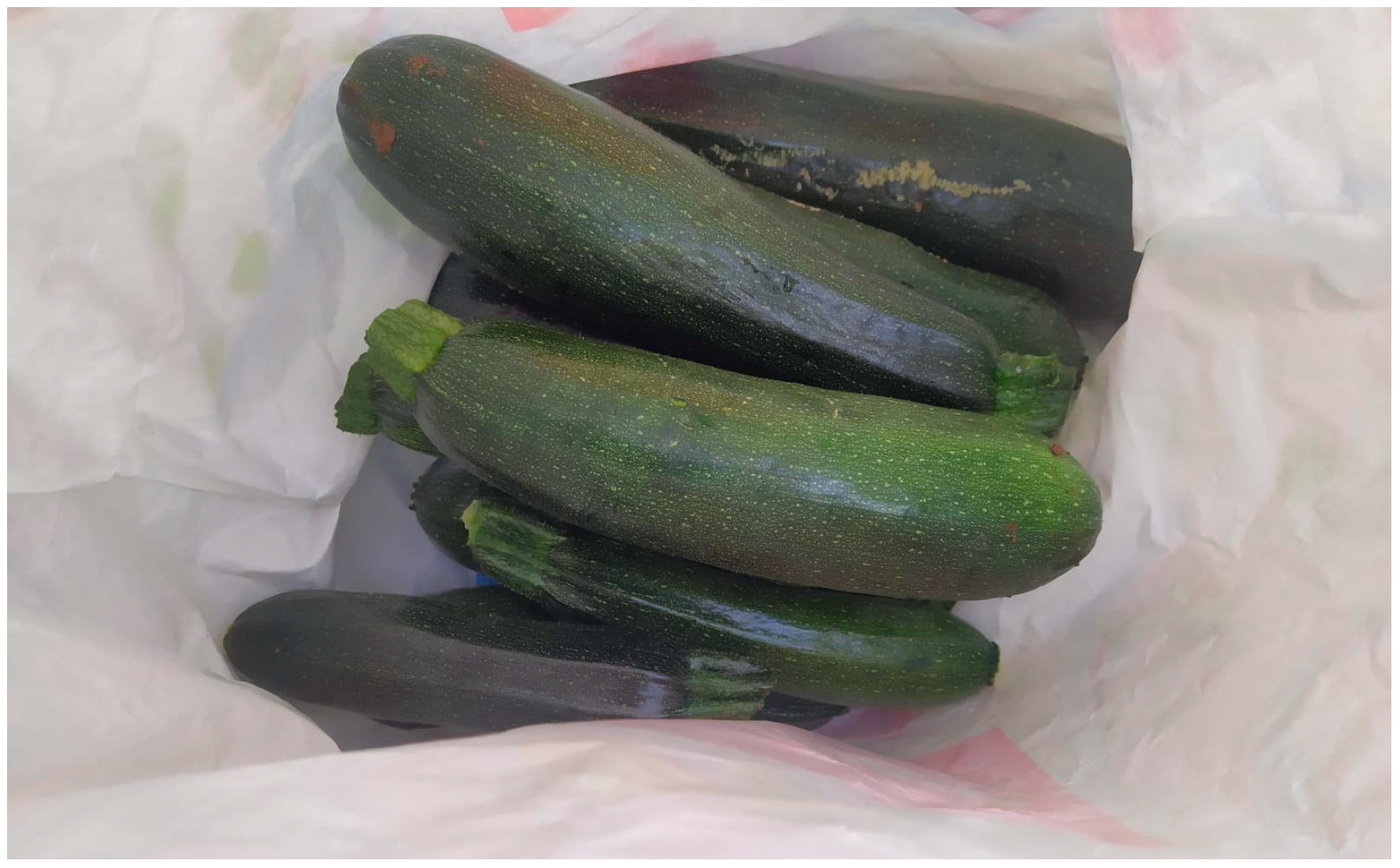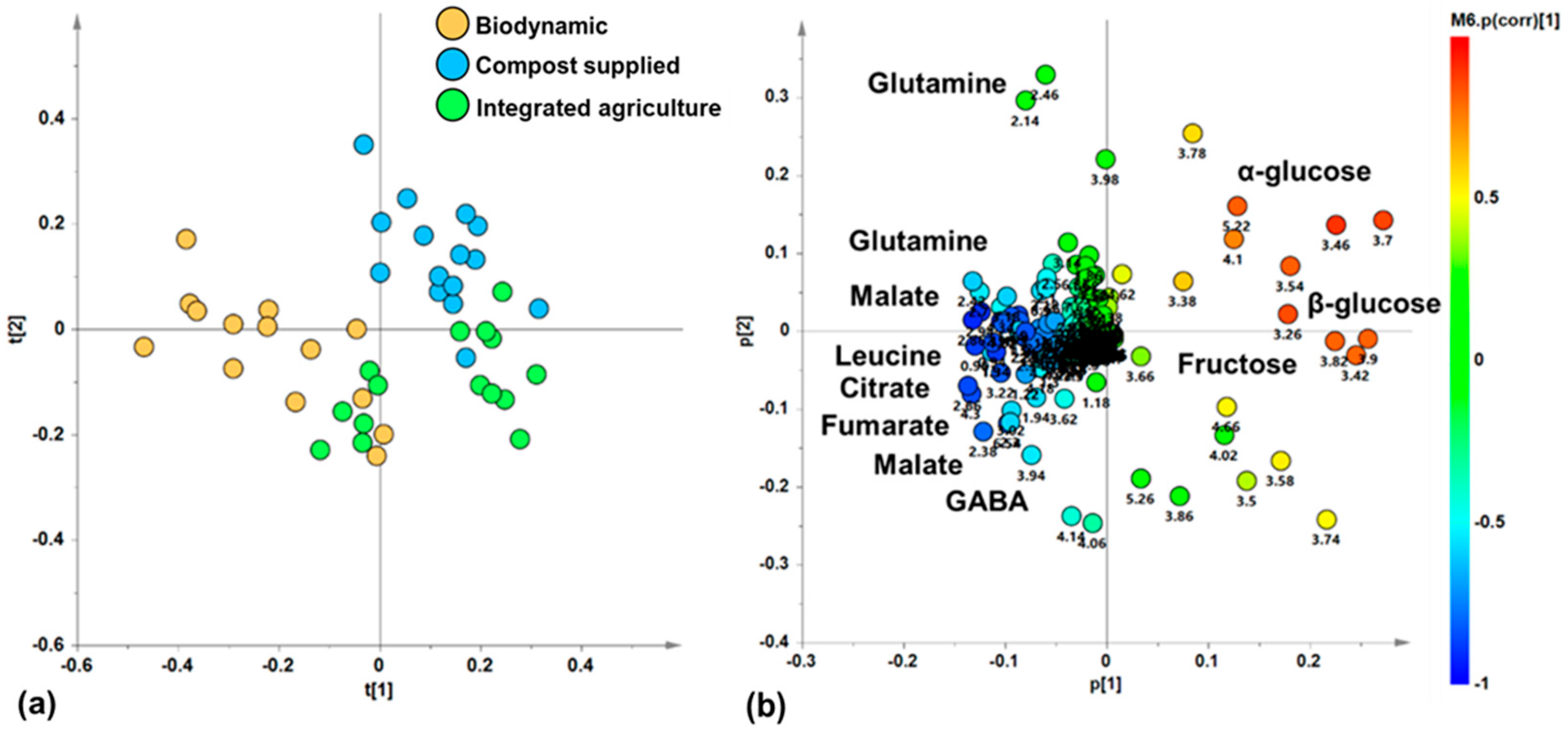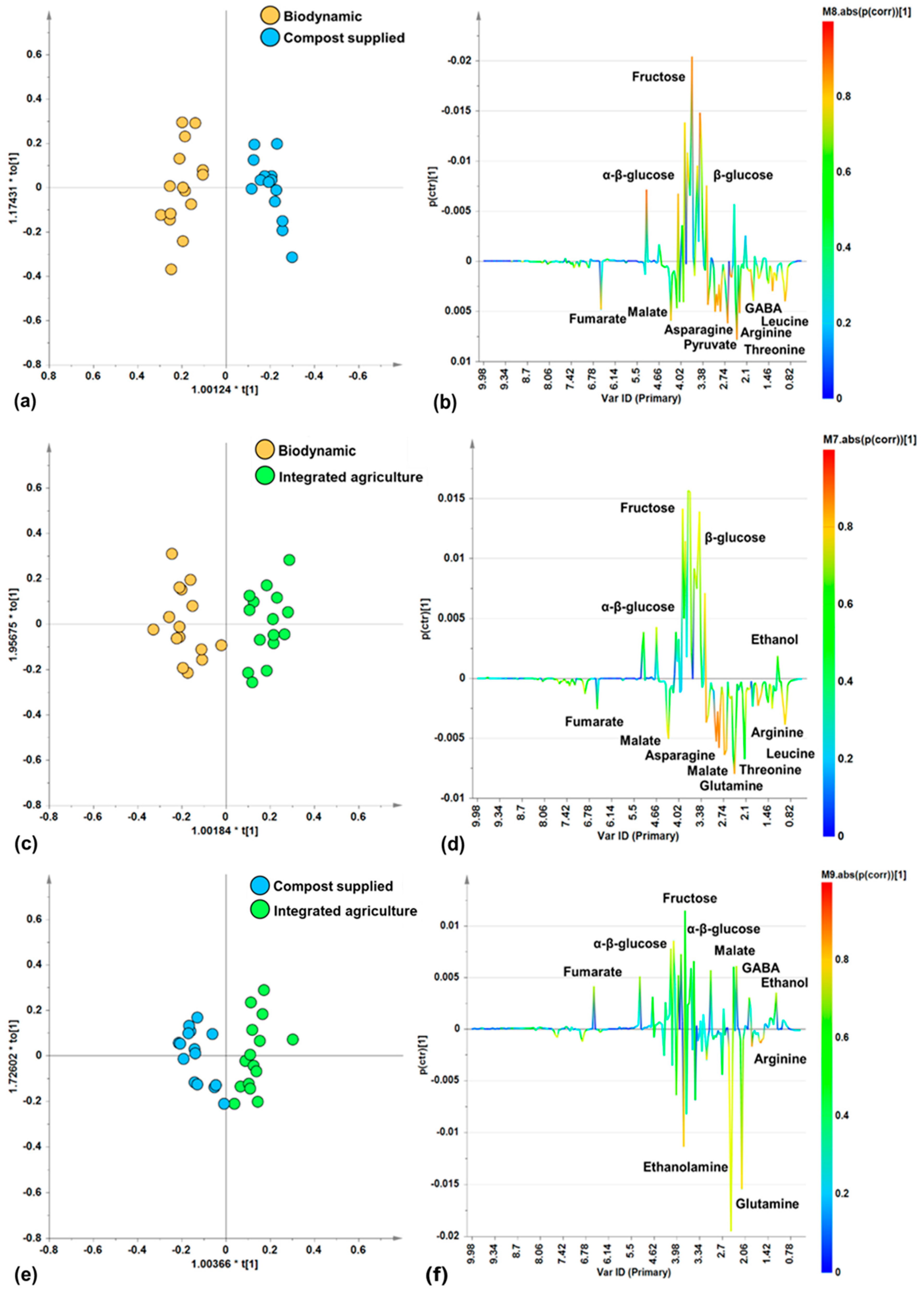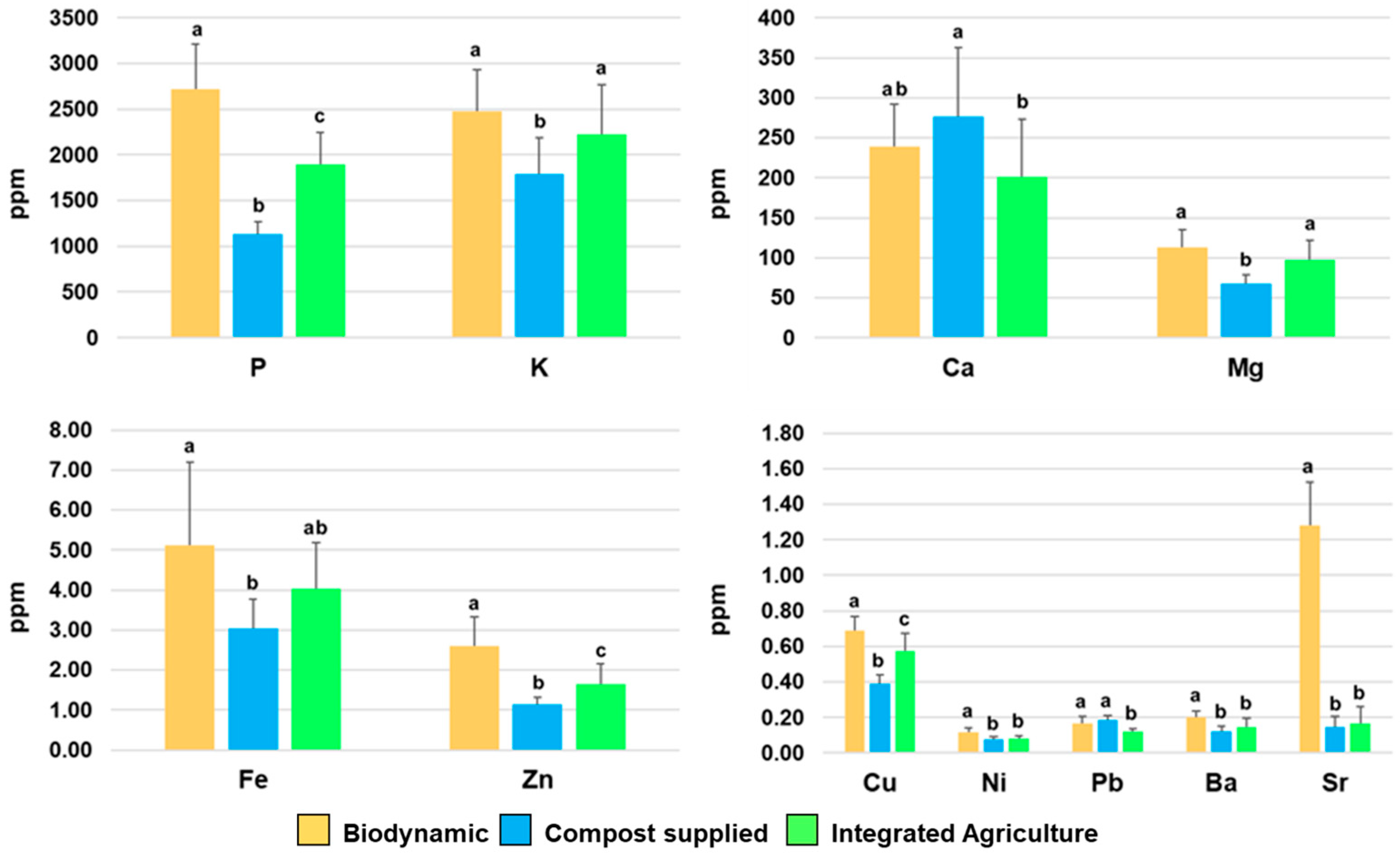1H-NMR-Based Metabolomic Profiles of Zucchini (Cucurbita pepo L.) Grown with Different Agricultural Practices for Sustainable Crop Production
Abstract
:1. Introduction
2. Materials and Methods
2.1. Zucchini Samples’ Origin, Collection, and Preparation
2.2. NMR Chemicals and Reagents
2.3. Sample Preparation and NMR Spectroscopy
2.4. NMR Data Processing and Statistical Analysis
2.5. Measurement of Element Content via ICP-AES Analysis
3. Results and Discussion
3.1. 1H-NMR Spectrum of Zucchini Juice Sample and Assignment of the Peaks
3.2. Statistical Analysis
3.3. Element Content in Different Zucchini Samples
4. Conclusions
Supplementary Materials
Author Contributions
Funding
Institutional Review Board Statement
Informed Consent Statement
Data Availability Statement
Acknowledgments
Conflicts of Interest
Abbreviations
| NMR | Nuclear magnetic resonance |
| ICP-AES | Inductively coupled plasma atomic emission spectroscopy |
| MVA | Multivariate statistical analysis |
| PCA | Principal component analysis |
| OPLS-DA | Orthogonal partial least squares discriminant analysis |
References
- Martínez-Valdivieso, D.; Font, R.; Fernández-Bedmar, Z.; Merinas-Amo, T.; Gómez, P.; Alonso-Moraga, Á.; Del Río-Celestino, M. Role of Zucchini and Its Distinctive Components in the Modulation of Degenerative Processes: Genotoxicity, Anti-Genotoxicity, Cytotoxicity and Apoptotic Effects. Nutrients 2017, 9, 755. [Google Scholar] [CrossRef] [PubMed]
- Iswaldi, I.; Gómez-Caravaca, A.M.; Lozano-Sánchez, J.; Arráez-Román, D.; Segura-Carretero, A.; Fernández-Gutiérrez, A. Profiling of Phenolic and Other Polar Compounds in Zucchini (Cucurbita pepo L.) by Reverse-Phase High-Performance Liquid Chromatography Coupled to Quadrupole Time-of-Flight Mass Spectrometry. Food Res. Int. 2013, 50, 77–84. [Google Scholar] [CrossRef]
- Cagliani, L.R.; Consonni, R. Monitoring the Metabolite Content of Seasoned Zucchinis during Storage by NMR-Based Metabolomics. Heliyon 2024, 10, e25976. [Google Scholar] [CrossRef] [PubMed]
- Sofi, F.; Macchi, C.; Abbate, R.; Gensini, G.F.; Casini, A. Mediterranean Diet and Health. BioFactors 2013, 39, 335–342. [Google Scholar] [CrossRef]
- Tejada, L.; Buendía-Moreno, L.; Villegas, A.; Cayuela, J.M.; Bueno-Gavilá, E.; Gómez, P.; Abellán, A. Nutritional and Sensorial Characteristics of Zucchini (Cucurbita pepo L.) as Affected by Freezing and the Culinary Treatment. Int. J. Food Prop. 2020, 23, 1825–1833. [Google Scholar] [CrossRef]
- Hounsome, N.; Hounsome, B.; Tomos, D.; Edwards-Jones, G. Plant Metabolites and Nutritional Quality of Vegetables. J. Food Sci. 2008, 73, R48–R65. [Google Scholar] [CrossRef]
- Dernini, S.; Berry, E.; Serra-Majem, L.; La Vecchia, C.; Capone, R.; Medina, F.; Aranceta-Bartrina, J.; Belahsen, R.; Burlingame, B.; Calabrese, G.; et al. Med Diet 4.0: The Mediterranean Diet with Four Sustainable Benefits. Public. Health Nutr. 2017, 20, 1322–1330. [Google Scholar] [CrossRef]
- Döring, J.; Frisch, M.; Tittmann, S.; Stoll, M.; Kauer, R. Growth, Yield and Fruit Quality of Grapevines under Organic and Biodynamic Management. PLoS ONE 2015, 10, e0138445. [Google Scholar] [CrossRef]
- Romero, H.; Pott, D.M.; Vallarino, J.G.; Osorio, S. Metabolomics-Based Evaluation of Crop Quality Changes as a Consequence of Climate Change. Metabolites 2021, 11, 461. [Google Scholar] [CrossRef]
- Rouphael, Y.; Cardarelli, M.; Bassal, A.; Leonardi, C.; Giuffrida, F.; Colla, G. Vegetable Quality as Affected by Genetic, Agronomic and Environmental Factors. J. Food Agric. Environ. 2012, 10, 680–688. [Google Scholar]
- Colì, C.S.; Girelli, C.R.; Cesari, G.; Hussain, M.; Fanizzi, F.P. Biodynamic, Organic and Integrated Agriculture Effects on Cv. Italia Table Grapes Juice, over a 3-Year Period Experiment: An 1H NMR Spectroscopy-Based Metabolomics Study. Chem. Biol. Technol. Agric. 2024, 11, 35. [Google Scholar] [CrossRef]
- Turinek, M.; Grobelnik-Mlakar, S.; Bavec, M.; Bavec, F. Biodynamic Agriculture Research Progress and Priorities. Renew. Agric. Food Syst. 2009, 24, 146–154. [Google Scholar] [CrossRef]
- Pergola, M.; Persiani, A.; Palese, A.M.; Di Meo, V.; Pastore, V.; D’Adamo, C.; Celano, G. Composting: The Way for a Sustainable Agriculture. Appl. Soil. Ecol. 2018, 123, 744–750. [Google Scholar] [CrossRef]
- Steiner, R. Impulsi Scientifico-Spirituali per IL Progresso Dell’Agricoltura: Corso Sull’Agricoltura, 7th ed.; Otto Conferenze e Un’allocuzione Tenute a Koberwitz Presso Breslavia dal 7 al 16 Giugno 1924 con Diverse Risposte a Domande e una Relazione Tenuta a Dornach il 20 Giugno 1924; Editrice Antroposofica: Milano, Italy, 2014; ISBN 978-88-7787-497-9. [Google Scholar]
- Santoni, M.; Ferretti, L.; Migliorini, P.; Vazzana, C.; Pacini, G.C. A Review of Scientific Research on Biodynamic Agriculture. Org. Agric. 2022, 12, 373–396. [Google Scholar] [CrossRef]
- Demeter—Biodynamic Federation Demeter International. Available online: https://demeter.net/ (accessed on 19 February 2025).
- FiBL IFOMA-Organics International. The World of Organic Agriculture: Statistics & Emerging Trends 2020; FiBL IFOMA-Organics International: Bonn, Germany, 2020; ISBN 978-3-03736-158-0. [Google Scholar]
- Biodynamic Preparations. Demeter International. 2021. Available online: https://www.demeter.net/wp-content/uploads/2021/11/BFDI_Biodynamic-Preparation-Manual-Plant-cultivation_2021_EN.pdf (accessed on 6 March 2025).
- Regolamento (UE) 2018/Del Parlamento Europeo e Del Consiglio, Del 30 Maggio 2018, Relativo Alla Produzione Biologica e All’etichettatura Dei Prodotti Biologici e Che Abroga Il Regolamento (CE) n.834/2007 Del Consiglio. Available online: https://eur-lex.europa.eu/legal-content/IT/TXT/PDF/?uri=CELEX:32018R0848 (accessed on 6 March 2025).
- Agnew, J.M.; Leonard, J.J. The Physical Properties of Compost. Compost. Sci. Util. 2003, 11, 238–264. [Google Scholar] [CrossRef]
- Martínez-Blanco, J.; Lazcano, C.; Christensen, T.H.; Muñoz, P.; Rieradevall, J.; Møller, J.; Antón, A.; Boldrin, A. Compost Benefits for Agriculture Evaluated by Life Cycle Assessment. A Review. Agron. Sustain. Dev. 2013, 33, 721–732. [Google Scholar] [CrossRef]
- Azim, K.; Soudi, B.; Boukhari, S.; Perissol, C.; Roussos, S.; Thami Alami, I. Composting Parameters and Compost Quality: A Literature Review. Org. Agric. 2018, 8, 141–158. [Google Scholar] [CrossRef]
- Cao, X.; Williams, P.N.; Zhan, Y.; Coughlin, S.A.; McGrath, J.W.; Chin, J.P.; Xu, Y. Municipal Solid Waste Compost: Global Trends and Biogeochemical Cycling. Soil Environ. Health 2023, 1, 100038. [Google Scholar] [CrossRef]
- Bio Vegetal. Tersan Puglia. 2017. Available online: https://www.tersan.it/bio-vegetal/ (accessed on 6 March 2025).
- Il Compostaggio. Tersan Puglia. 2016. Available online: https://www.tersan.it/il-processo-di-compostaggio-tersan/ (accessed on 6 March 2025).
- Çakmakçı, R.; Salık, M.A.; Çakmakçı, S. Assessment and Principles of Environmentally Sustainable Food and Agriculture Systems. Agriculture 2023, 13, 1073. [Google Scholar] [CrossRef]
- Boschiero, M.; De Laurentiis, V.; Caldeira, C.; Sala, S. Comparison of Organic and Conventional Cropping Systems: A Systematic Review of Life Cycle Assessment Studies. Environ. Impact Assess. Rev. 2023, 102, 107187. [Google Scholar] [CrossRef]
- Wright, J. A Revitalisation of European Farming and the Promise of the Biodynamic Worldview. Chem. Biol. Technol. Agric. 2022, 9, 64. [Google Scholar] [CrossRef]
- Azarbad, H. Conventional vs. Organic Agriculture–Which One Promotes Better Yields and Microbial Resilience in Rapidly Changing Climates? Front. Microbiol. 2022, 13, 903500. [Google Scholar] [CrossRef] [PubMed]
- Sumberg, J.; Giller, K.E. What Is ‘Conventional’ Agriculture? Glob. Food Secur. 2022, 32, 100617. [Google Scholar] [CrossRef]
- Abreu, A.C.; Aguilera-Sáez, L.M.; Peña, A.; García-Valverde, M.; Marín, P.; Valera, D.L.; Fernández, I. NMR-Based Metabolomics Approach To Study the Influence of Different Conditions of Water Irrigation and Greenhouse Ventilation on Zucchini Crops. J. Agric. Food Chem. 2018, 66, 8422–8432. [Google Scholar] [CrossRef]
- Girelli, C.R.; Accogli, R.; Del Coco, L.; Angilè, F.; De Bellis, L.; Fanizzi, F.P. 1H-NMR-Based Metabolomic Profiles of Different Sweet Melon (Cucumis melo L.) Salento Varieties: Analysis and Comparison. Food Res. Int. 2018, 114, 81–89. [Google Scholar] [CrossRef]
- Vignoli, A.; Ghini, V.; Meoni, G.; Licari, C.; Takis, P.G.; Tenori, L.; Turano, P.; Luchinat, C. High-Throughput Metabolomics by 1D NMR. Angew. Chem. Int. Ed. 2019, 58, 968–994. [Google Scholar] [CrossRef]
- Al-Akl, N.S.; Khalifa, O.; Ponirakis, G.; Parray, A.; Ramadan, M.; Khan, S.; Chandran, M.; Ayadathil, R.; Elsotouhy, A.; Own, A.; et al. Untargeted Metabolomic Profiling Reveals Differentially Expressed Serum Metabolites and Pathways in Type 2 Diabetes Patients with and without Cognitive Decline: A Cross-Sectional Study. Int. J. Mol. Sci. 2024, 25, 2247. [Google Scholar] [CrossRef]
- Serio, F.; Girelli, C.R.; Acito, M.; Imbriani, G.; Sabella, E.; Moretti, M.; Fanizzi, F.P.; Valacchi, G. Preliminary Characterization of “Salice Salentino” PDO Wines from Salento (South Italy) Negroamaro Grapes: NMR-Based Metabolomic and Biotoxicological Analyses. Foods 2024, 13, 3554. [Google Scholar] [CrossRef]
- Papadia, P.; Del Coco, L.; Muzzalupo, I.; Rizzi, M.; Perri, E.; Cesari, G.; Simeone, V.; Mondelli, D.; Schena, F.P.; Fanizzi, F.P. Multivariate Analysis of 1H-NMR Spectra of Genetically Characterized Extra Virgin Olive Oils and Growth Soil Correlations. J. Am. Oil Chem. Soc. 2011, 88, 1463. [Google Scholar] [CrossRef]
- Girelli, C.R.; Serio, F.; Accogli, R.; Angilè, F.; De Donno, A.; Fanizzi, F.P. First Insight into Nutraceutical Properties of Local Salento Cichorium Intybus Varieties: NMR-Based Metabolomic Approach. Int. J. Environ. Res. Public. Health 2021, 18, 4057. [Google Scholar] [CrossRef]
- Sobolev, A.; Mannina, L.; Proietti, N.; Carradori, S.; Daglia, M.; Giusti, A.; Antiochia, R.; Capitani, D. Untargeted NMR-Based Methodology in the Study of Fruit Metabolites. Molecules 2015, 20, 4088–4108. [Google Scholar] [CrossRef] [PubMed]
- Girelli, C.R.; De Pascali, S.A.; Del Coco, L.; Fanizzi, F.P. Metabolic Profile Comparison of Fruit Juice from Certified Sweet Cherry Trees (Prunus avium L.) of Ferrovia and Giorgia Cultivars: A Preliminary Study. Food Res. Int. 2016, 90, 281–287. [Google Scholar] [CrossRef] [PubMed]
- Girelli, C.R.; Papadia, P.; Pagano, F.; Miglietta, P.P.; Fanizzi, F.P.; Cardinale, M.; Rustioni, L. Metabolomic NMR Analysis and Organoleptic Perceptions of Pomegranate Wines: Influence of Cultivar and Yeast on the Product Characteristics. Heliyon 2023, 9, e16774. [Google Scholar] [CrossRef]
- Savorani, F.; Rasmussen, M.A.; Mikkelsen, M.S.; Engelsen, S.B. A Primer to Nutritional Metabolomics by NMR Spectroscopy and Chemometrics. Food Res. Int. 2013, 54, 1131–1145. [Google Scholar] [CrossRef]
- Picone, G.; Trimigno, A.; Tessarin, P.; Donnini, S.; Rombolà, A.D.; Capozzi, F. 1H NMR Foodomics Reveals That the Biodynamic and the Organic Cultivation Managements Produce Different Grape Berries (Vitis vinifera L. Cv. Sangiovese). Food Chem. 2016, 213, 187–195. [Google Scholar] [CrossRef]
- Gallo, V.; Mastrorilli, P.; Cafagna, I.; Nitti, G.I.; Latronico, M.; Longobardi, F.; Minoja, A.P.; Napoli, C.; Romito, V.A.; Schäfer, H.; et al. Effects of Agronomical Practices on Chemical Composition of Table Grapes Evaluated by NMR Spectroscopy. J. Food Compos. Anal. 2014, 35, 44–52. [Google Scholar] [CrossRef]
- Lucarini, M.; Di Cocco, M.E.; Raguso, V.; Milanetti, F.; Durazzo, A.; Lombardi-Boccia, G.; Santini, A.; Delfini, M.; Sciubba, F. NMR-Based Metabolomic Comparison of Brassica Oleracea (Var. Italica): Organic and Conventional Farming. Foods 2020, 9, 945. [Google Scholar] [CrossRef]
- Pacifico, D.; Casciani, L.; Ritota, M.; Mandolino, G.; Onofri, C.; Moschella, A.; Parisi, B.; Cafiero, C.; Valentini, M. NMR-Based Metabolomics for Organic Farming Traceability of Early Potatoes. J. Agric. Food Chem. 2013, 61, 11201–11211. [Google Scholar] [CrossRef]
- Hussain, M.; Girelli, C.R.; Verweire, D.; Oehl, M.C.; Avendaño, M.S.; Scortichini, M.; Fanizzi, F.P. 1H-NMR Metabolomics Study after Foliar and Endo-Therapy Treatments of Xylella fastidiosa Subsp. Pauca Infected Olive Trees: Medium Time Monitoring of Field Experiments. Plants 2023, 12, 1946. [Google Scholar] [CrossRef]
- Van Den Berg, R.A.; Hoefsloot, H.C.; Westerhuis, J.A.; Smilde, A.K.; Van Der Werf, M.J. Centering, Scaling, and Transformations: Improving the Biological Information Content of Metabolomics Data. BMC Genom. 2006, 7, 142. [Google Scholar] [CrossRef]
- Eriksson, L.; Byrne, T.; Johansson, E.; Trygg, J.; Vikström, C. Multi—And Megavariate Data Analysis Basic Principles and Applications; Umetrics Academy: Vasterbottens Lan, Sweden, 2013; Volume 1, ISBN 91-973730-5-2. [Google Scholar]
- Jackson, J.E. A User’s Guide to Principal Components; John Wiley & Sons: Hoboken, NJ, USA, 2005; ISBN 0-471-72532-3. [Google Scholar]
- Kettaneh, N.; Berglund, A.; Wold, S. PCA and PLS with Very Large Data Sets. Comput. Stat. Data Anal. 2005, 48, 69–85. [Google Scholar] [CrossRef]
- Chen, Y.; Li, E.-M.; Xu, L.-Y. Guide to Metabolomics Analysis: A Bioinformatics Workflow. Metabolites 2022, 12, 357. [Google Scholar] [CrossRef] [PubMed]
- Eriksson, L.; Rosén, J.; Johansson, E.; Trygg, J. Orthogonal PLS (OPLS) Modeling for Improved Analysis and Interpretation in Drug Design. Mol. Inform. 2012, 31, 414–419. [Google Scholar] [CrossRef] [PubMed]
- Wold, S.; Eriksson, L.; Trygg, J.; Kettaneh, N. The PLS Method—Partial Least Squares Projections to Latent Structures—And Its Applications in Industrial RDP (Research, Development, and Production). In COMPSTAT 2004, Proceedings of the Computational Statistics, 16th Symposium of IASC, Prague, Czech Republic, January 2004; Springer: Berlin/Heidelberg, Germany, 2004. [Google Scholar]
- Trygg, J.; Wold, S. Orthogonal Projections to Latent Structures (O-PLS). J. Chemom. 2002, 16, 119–128. [Google Scholar] [CrossRef]
- Wheelock, Å.M.; Wheelock, C.E. Trials and Tribulations of ‘omics Data Analysis: Assessing Quality of SIMCA-Based Multivariate Models Using Examples from Pulmonary Medicine. Mol. Biosyst. 2013, 9, 2589. [Google Scholar] [CrossRef]
- Leleu, G.; Garcia, L.; Homobono Brito De Moura, P.; Da Costa, G.; Saucier, C.; Richard, T. Cork Impact on Red Wine Aging Monitoring through 1H NMR Metabolomics: A Comprehensive Approach. Food Res. Int. 2025, 203, 115772. [Google Scholar] [CrossRef]
- Angilè, F.; Vivaldi, G.A.; Girelli, C.R.; Del Coco, L.; Caponio, G.; Lopriore, G.; Fanizzi, F.P.; Camposeo, S. Treated Unconventional Waters Combined with Different Irrigation Strategies Affect 1H NMR Metabolic Profile of a Monovarietal Extra Virgin Olive Oil. Sustainability 2022, 14, 1592. [Google Scholar] [CrossRef]
- Cocchi, M.; Biancolillo, A.; Marini, F. Chemometric Methods for Classification and Feature Selection. Compr. Anal. Chem. 2018, 82, 265–299. [Google Scholar]
- Scortichini, M.; Chen, J.; de Caroli, M.; Dalessandro, G.; Pucci, N.; Modesti, V.; L’aurora, A.; Petriccione, M.; Zampella, L.; Mastrobuoni, F.; et al. A Zinc, Copper and Citric Acid Biocomplex Shows Promise for Control of Xylella fastidiosa Subsp. pauca in Olive Trees in Apulia Region (Southern Italy). Phytopathol. Mediterr. 2018, 57, 48–72. [Google Scholar] [CrossRef]
- Scortichini, M.; Migoni, D.; Angilè, F.; Del Coco, L.; Girelli, C.R.; Zampella, L.; Mastrobuoni, F.; Fanizzi, F.P. Xylella fastidiosa Subsp. Pauca on Olive in Salento (Southern Italy). Phytopathol. Mediterr. 2019, 58, 39–48. [Google Scholar]
- MetaboAnalyst. Available online: https://www.metaboanalyst.ca/MetaboAnalyst/ModuleView.xhtml (accessed on 16 January 2025).
- Liang, Y.; Dai, X.; Cao, Y.; Wang, X.; Lu, J.; Xie, L.; Liu, K.; Li, X. The Neuroprotective and Antidiabetic Effects of Trigonelline: A Review of Signaling Pathways and Molecular Mechanisms. Biochimie 2023, 206, 93–104. [Google Scholar] [CrossRef]
- Ashihara, H. Trigonelline (N-Methylnicotinic Acid) Biosynthesis and Its Biological Role in Plants. Nat. Prod. Commun. 2008, 3, 1934578X0800300. [Google Scholar] [CrossRef]
- Kopczyńska, K.; Kazimierczak, R.; Średnicka-Tober, D.; Barański, M.; Wyszyński, Z.; Kucińska, K.; Perzanowska, A.; Szacki, P.; Rembiałkowska, E.; Hallmann, E. The Profile of Selected Antioxidants in Two Courgette Varieties from Organic and Conventional Production. Antioxidants 2020, 9, 404. [Google Scholar] [CrossRef] [PubMed]
- Lea, P.J.; Sodek, L.; Parry, M.A.J.; Shewry, P.R.; Halford, N.G. Asparagine in Plants. Ann. Appl. Biol. 2007, 150, 1–26. [Google Scholar] [CrossRef]
- Ramos-Ruiz, R.; Martinez, F.; Knauf-Beiter, G. The Effects of GABA in Plants. Cogent Food Agric. 2019, 5, 1670553. [Google Scholar] [CrossRef]
- Panchal, P.; Miller, A.J.; Giri, J. Organic Acids: Versatile Stress-Response Roles in Plants. J. Exp. Bot. 2021, 72, 4038–4052. [Google Scholar] [CrossRef]
- Chahardoli, A.; Jalilian, F.; Memariani, Z.; Farzaei, M.H.; Shokoohinia, Y. Analysis of Organic Acids. In Recent Advances in Natural Products Analysis; Elsevier: Amsterdam, The Netherlands, 2020; pp. 767–823. ISBN 978-0-12-816455-6. [Google Scholar]
- Modolo, L.V.; Augusto, O.; Almeida, I.M.G.; Pinto-Maglio, C.A.F.; Oliveira, H.C.; Seligman, K.; Salgado, I. Decreased Arginine and Nitrite Levels in Nitrate Reductase-Deficient Arabidopsis Thaliana Plants Impair Nitric Oxide Synthesis and the Hypersensitive Response to Pseudomonas Syringae. Plant Sci. 2006, 171, 34–40. [Google Scholar] [CrossRef]
- Biais, B.; Allwood, J.W.; Deborde, C.; Xu, Y.; Maucourt, M.; Beauvoit, B.; Dunn, W.B.; Jacob, D.; Goodacre, R.; Rolin, D.; et al. 1H NMR, GC−EI-TOFMS, and Data Set Correlation for Fruit Metabolomics: Application to Spatial Metabolite Analysis in Melon. Anal. Chem. 2009, 81, 2884–2894. [Google Scholar] [CrossRef]
- Dudley, R. Ethanol, Fruit Ripening, and the Historical Origins of Human Alcoholism in Primate Frugivory. Integr. Comp. Biol. 2004, 44, 315–323. [Google Scholar] [CrossRef]
- Popović-Djordjević, J.B.; Kostić, A.Ž.; Rajković, M.B.; Miljković, I.; Krstić, Đ.; Caruso, G.; Siavash Moghaddam, S.; Brčeski, I. Organically vs. Conventionally Grown Vegetables: Multi-Elemental Analysis and Nutritional Evaluation. Biol. Trace Elem. Res. 2022, 200, 426–436. [Google Scholar] [CrossRef]
- Golubkina, N.A.; Seredin, T.M.; Antoshkina, M.S.; Kosheleva, O.V.; Teliban, G.C.; Caruso, G. Yield, Quality, Antioxidants and Elemental Composition of New Leek Cultivars under Organic or Conventional Systems in a Greenhouse. Horticulturae 2018, 4, 39. [Google Scholar] [CrossRef]
- D’Evoli, L.; Lucarini, M.; Del Pulgar, J.S.; Aguzzi, A.; Gabrielli, P.; Gambelli, L.; Lombardi-Boccia, G. Phenolic Acids Content and Nutritional Quality of Conventional, Organic and Biodynamic Cultivations of the Tomato CXD271BIO Breeding Line (Solanum lycopersicum L.). Food Nutr. Sci. 2016, 7, 1112–1121. [Google Scholar] [CrossRef]
- Lombardo, S.; Pandino, G.; Mauromicale, G. The Mineral Profile in Organically and Conventionally Grown “Early” Crop Potato Tubers. Sci. Hortic. 2014, 167, 169–173. [Google Scholar] [CrossRef]
- Wang, Z.; Li, S.; Malhi, S. Effects of Fertilization and Other Agronomic Measures on Nutritional Quality of Crops. J. Sci. Food Agric. 2008, 88, 7–23. [Google Scholar] [CrossRef]
- Montgomery, D.R.; Biklé, A. Soil Health and Nutrient Density: Beyond Organic vs. Conventional Farming. Front. Sustain. Food Syst. 2021, 5, 699147. [Google Scholar] [CrossRef]
- Calabrese, A.; Mandrelli, L.; Loi, E.; Blonda, M. Chemical and Microbiological Characterization of Soil under Different Agronomical Use and Practical: First Focus on Nitrogen Cycles. IOSR J. Biotechnol. Biochem. 2020, 6, 45–57. [Google Scholar]
- Platis, D.P.; Anagnostopoulos, C.D.; Tsaboula, A.D.; Menexes, G.C.; Kalburtji, K.L.; Mamolos, A.P. Energy Analysis, and Carbon and Water Footprint for Environmentally Friendly Farming Practices in Agroecosystems and Agroforestry. Sustainability 2019, 11, 1664. [Google Scholar] [CrossRef]






| Metabolites | Assignment | 1H ppm | Multiplicity *; J (Hz) | 13C ppm |
|---|---|---|---|---|
| Valine | γ′-CH3 γ-CH3 β-CH | 1.05 0.99 2.27 | d [7.0] d [7.0] m | 20 19.3 |
| Isoleucine | γ-CH3 δ-CH3 | 1.01 0.94 | d [7.2] t [7.36] | 19 13.08 |
| Leucine | γ-CH3 γ′-CH3 | 0.96 0.97 | d d | 23 23 |
| Ethanol | β-CH3 α-CH2 | 1.17 3.66 | t [7.26] q | |
| Threonine | γ-CH3 β-CH | 1.33 4.25 | d [6.28] m | 22 |
| Alanine | β-CH3 α-CH -COOH | 1.47 3.77 | D [7.3] q | 19.3 179.3 |
| Arginine | γ-CH2 β-CH2 | 1.72 1.90 | m m | 30 26.9 |
| GABA | β-CH2 α-CH2 γ-CH2 -COOH | 1.90 2.30 3.0 | m t [7.58] t [7.4] | 26.63 37.05 42.29 184.6 |
| Acetate | β-CH3 | 1.92 | s | |
| Glutamine | γ-CH2 β-CH2 | 2.44 (m) 2.14 (m) | m m | 33.84 29 |
| Malate | α-CH β′-CH β-CH -COOH | 4.31 2.70 2.40 | dd [10; 3] dd [15.1; 3.15] dd [15.2; 10] | 72.6 44 44 183 |
| Citrate | CH2 | 2.54 | d | |
| Aspartate | β-CH β′-CH | 2.80 2.64 | dd [17.9; 3.7] dd | 39.4 39.4 |
| Asparagine | β-CH β′-CH COOH | 2.94 [16.7; 4.2] 2.83 [16.6; 7.4] | dd dd | 37.4 37.4 176 |
| Ethanolamine | CH2-NH2 | 3.12 | t | 44 |
| Choline | N(CH3)3 | 3.20 | s | 56 |
| Myo-inositol | C2H C4H C5H | 4.07 3.62 3.28 | t t t | 77 |
| β-glucose | C1H C3H C2H | 4.64 3.48 3.26 | d[8.3] dd t [8.0] | 98 77 |
| α-glucose | C1H C2H | 5.23 3.51 | d [3.74] t | 95 |
| Sucrose | G1H G2H | 5.38 3.55 | d [3.8] dd | |
| α/β-fructofuranose | C3H C5H | 4.11 3.84 | 78 83 | |
| β-fructopyranose | C5H CH2-6,6′ CH2-1,1′ | 4.02 3.70 3.72; 3.58 | 71 63.4 | |
| Uridine | C5H, ring C6H, ring | 7.90 5.91 | d [8.84] d [7.97] | |
| Adenosine | C2H, ring CH8, ring C1′H, ribose | 8.35 8.27 6.07 | s s d | |
| Fumarate | α,β-C=C -COOH | 6.52 | s | 138 178.4 |
| Uracil | CH5, ring CH6, ring | 7.53 5.8 | d d | |
| Trigonelline | N-CH CH-3,5 CH-5 | 9.12 8.85 8.10 | s t dd | |
| Histidine | CH2-ring CH4-ring | 8.0 7.14 | s s | |
| Tryptophan | CH4, ring CH7, ring CH5, ring | 7.72 7.55 7.19 | d d d | 131 |
| Tyrosine | CH2, CH6, ring CH3, CH5 ring | 7.19 6.90 | d [8.3] d [8.0] | 133 118 |
| Phenylalanine | CH4, ring CH3,5-ring CH2,6-ring | 7.38 7.43 7.33 | m m m | 132 132.3 |
| Pairwise Comparison | R2X (cum) | R2Y (cum) | Q2 (cum) | Permutation Test R2; Q2 Intercepts | CV-ANOVA | Fisher’s Probability * |
|---|---|---|---|---|---|---|
| Biodynamic vs. Compost Supplied | 0.741 | 0.933 | 0.853 | 0.24; −0.522 | 1.66 × 10−8 | 2.7 × 10−8 |
| Biodynamic vs. Integrated Agriculture | 0.725 | 0.888 | 0.733 | 0.265; −0.685 | 1.21 × 10−5 | 2.7 × 10−8 |
| Compost Supplied vs. Integrated Agriculture | 0.646 | 0.831 | 0.684 | 0.269; −0.536 | 7.40 × 10−5 | 6.4 × 10−9 |
Disclaimer/Publisher’s Note: The statements, opinions and data contained in all publications are solely those of the individual author(s) and contributor(s) and not of MDPI and/or the editor(s). MDPI and/or the editor(s) disclaim responsibility for any injury to people or property resulting from any ideas, methods, instructions or products referred to in the content. |
© 2025 by the authors. Licensee MDPI, Basel, Switzerland. This article is an open access article distributed under the terms and conditions of the Creative Commons Attribution (CC BY) license (https://creativecommons.org/licenses/by/4.0/).
Share and Cite
Fazzi, M.C.; Girelli, C.R.; Migoni, D.; Fracasso, B.; Cesari, G.; Fanizzi, F.P. 1H-NMR-Based Metabolomic Profiles of Zucchini (Cucurbita pepo L.) Grown with Different Agricultural Practices for Sustainable Crop Production. Foods 2025, 14, 919. https://doi.org/10.3390/foods14060919
Fazzi MC, Girelli CR, Migoni D, Fracasso B, Cesari G, Fanizzi FP. 1H-NMR-Based Metabolomic Profiles of Zucchini (Cucurbita pepo L.) Grown with Different Agricultural Practices for Sustainable Crop Production. Foods. 2025; 14(6):919. https://doi.org/10.3390/foods14060919
Chicago/Turabian StyleFazzi, Miriana Carla, Chiara Roberta Girelli, Danilo Migoni, Beatrice Fracasso, Gianluigi Cesari, and Francesco Paolo Fanizzi. 2025. "1H-NMR-Based Metabolomic Profiles of Zucchini (Cucurbita pepo L.) Grown with Different Agricultural Practices for Sustainable Crop Production" Foods 14, no. 6: 919. https://doi.org/10.3390/foods14060919
APA StyleFazzi, M. C., Girelli, C. R., Migoni, D., Fracasso, B., Cesari, G., & Fanizzi, F. P. (2025). 1H-NMR-Based Metabolomic Profiles of Zucchini (Cucurbita pepo L.) Grown with Different Agricultural Practices for Sustainable Crop Production. Foods, 14(6), 919. https://doi.org/10.3390/foods14060919










